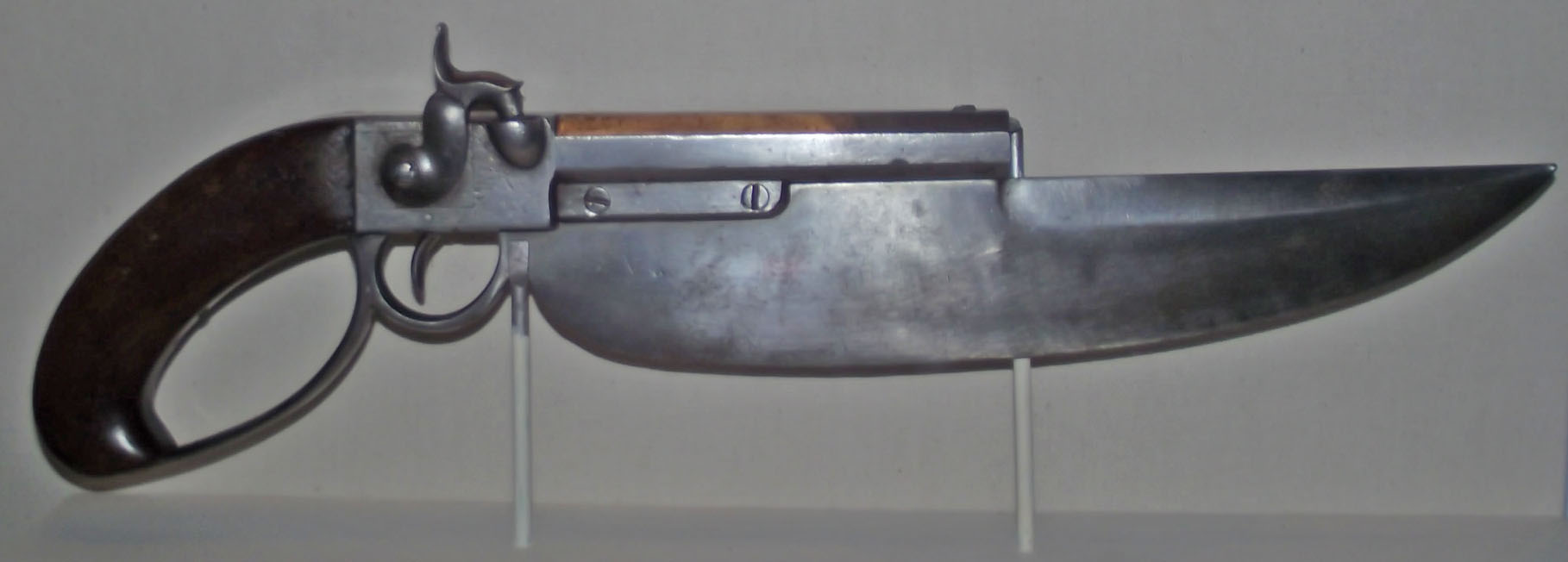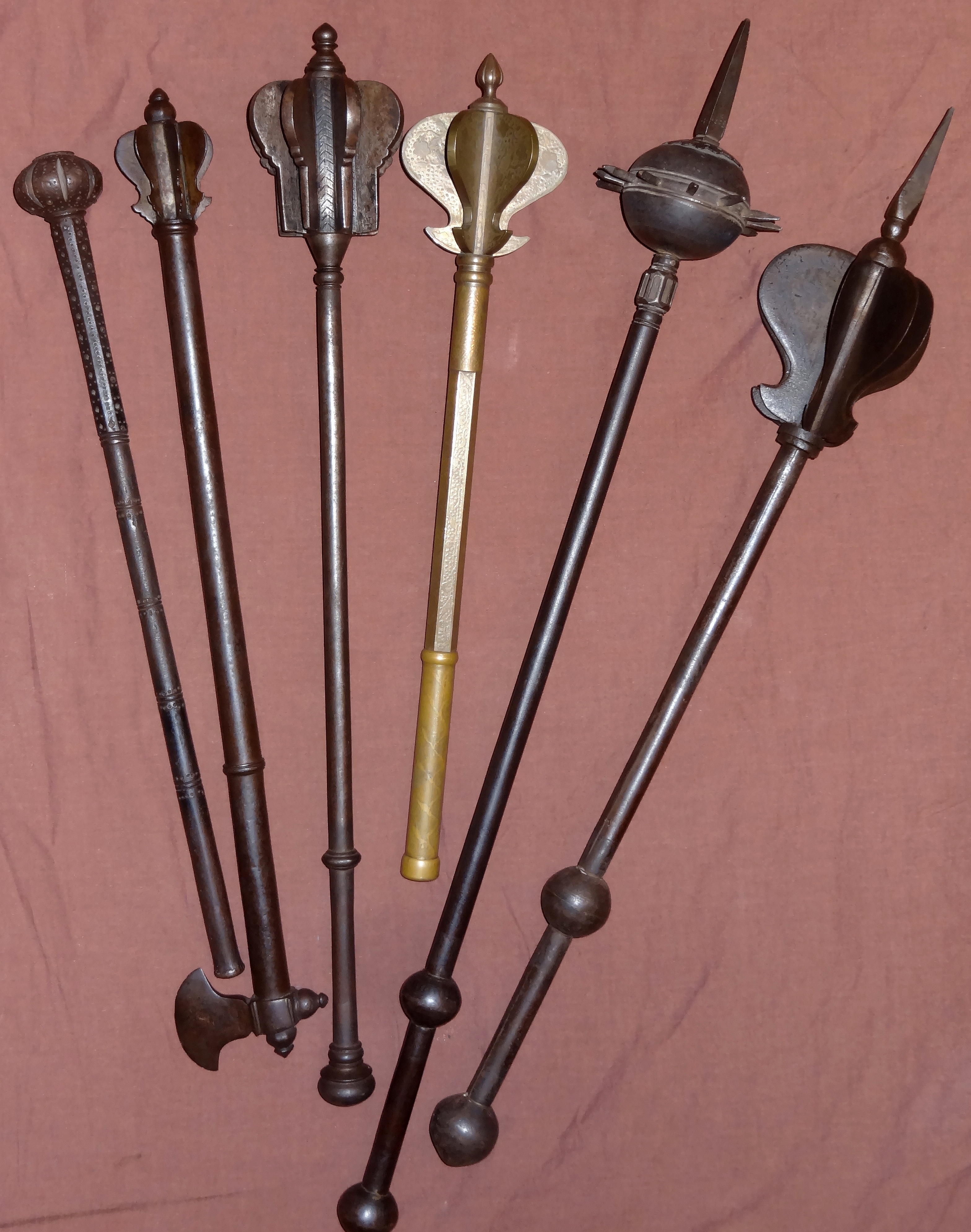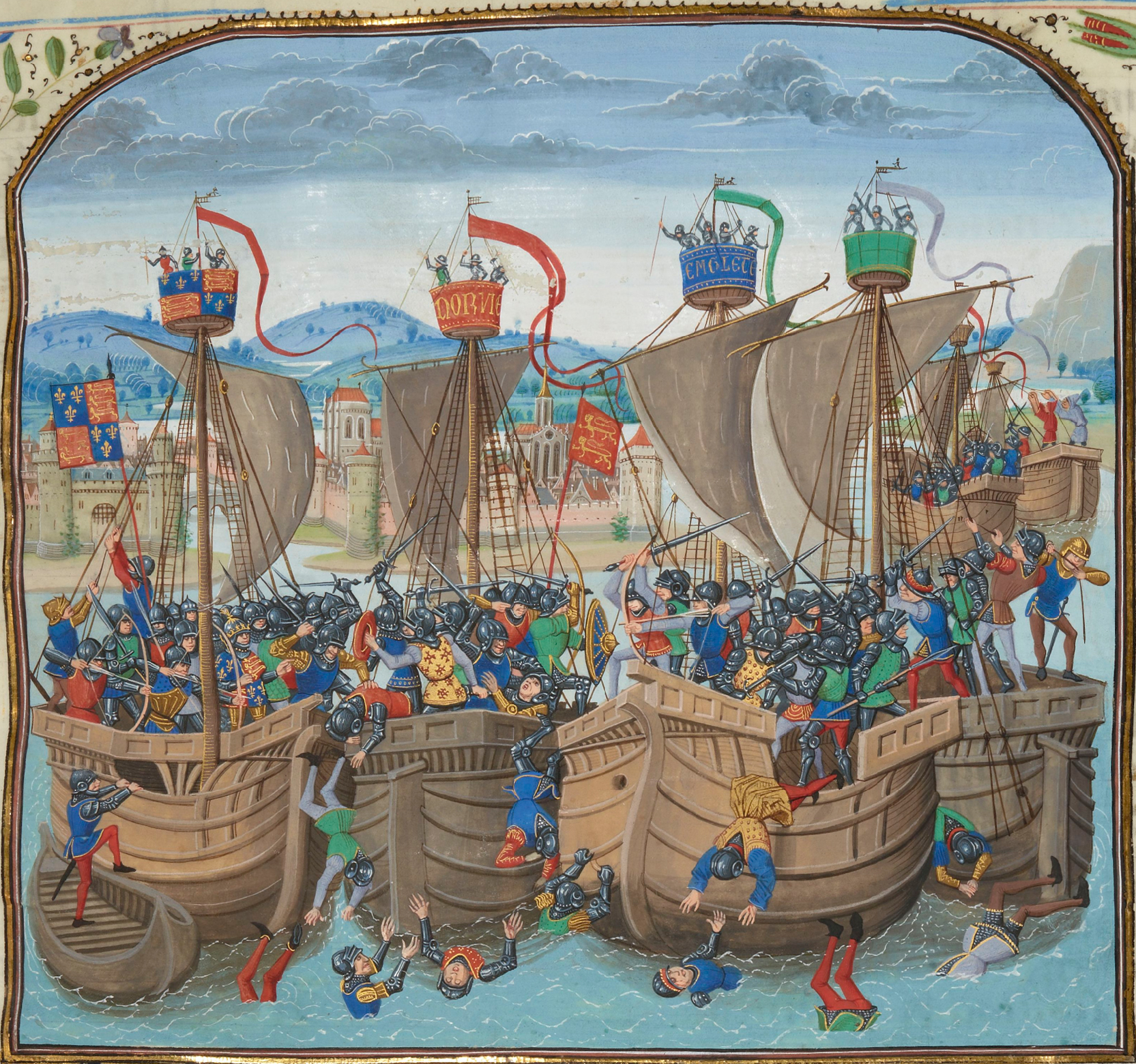|
Combination Weapons
A combination weapon is a close-quarters gun hybrid combining the features of both a firearm and an edged melee weapon.Richard Holmes,''Weapon: A Visual History of Arms and Armour'',,p.158. Examples of gun hybrids include knife/pistols and pistol/sword combinations. History According to the book ''Weaponry: An Illustrated History'', by Chuck Wills, between the late 16th century and the advances in repeating firearms in the mid 19th century, blades or clubs were often fitted onto guns, because only one shot could be fired from the gun. Without an alternative weapon attachment, they became useless at close range. Some of the first included the German axe-pistol, made in the central European region of Silesia. This weapon combined a flintlock pistol with a battleaxe. Later, a pistol-sword combination formed in the mid 18th century, which was apparently used mainly by marines and naval officers in boarding engagements at sea. Additionally, Dumonthier & Sons produced several knife pisto ... [...More Info...] [...Related Items...] OR: [Wikipedia] [Google] [Baidu] |
Close Combat
Close combat means a violent physical confrontation between two or more opponents at short range.''MCRP 3-02B: Close Combat'', Washington, D.C.: Department Of The Navy, Headquarters United States Marine Corps, 12 February 1999Matthews, Phil, CQB Services, retrieved 29 July 2011: At his Specialist Close Combat Course, combat instructor Capt. William E. Fairbairn defined close combat as "fighting an enemy hand to hand or within 20 yards range.” Armed and unarmed confrontations Among many types of fighting encompassed by the general term ''close combat'' are the modern terms '' hand-to-hand combat'' (HTH) and ''close-quarters combat'' (CQC). Close combat occurs when opposing military forces engage in restricted areas, an environment frequently encountered in urban warfare. Military small unit tactics traditionally regarded as forms of close combat include fighting with hand-held or hand-thrown weapons such as swords, knives, axes, or tools. In modern times, (since World War II), ... [...More Info...] [...Related Items...] OR: [Wikipedia] [Google] [Baidu] |
Percussion Cap
The percussion cap or percussion primer, introduced in the early 1820s, is a type of single-use percussion ignition device for muzzle loader firearm locks enabling them to fire reliably in any weather condition. This crucial invention gave rise to the cap lock mechanism or percussion lock system using percussion caps struck by the hammer to set off the gunpowder charge in percussion guns including percussion rifles and cap and ball firearms. Any firearm using a caplock mechanism is a percussion gun. Any long gun with a cap-lock mechanism and rifled barrel is a percussion rifle. Cap and ball describes cap-lock firearms discharging a single bore-diameter spherical bullet with each shot. Description The percussion cap is a small cylinder of copper or brass with one closed end. Inside the closed end is a small amount of a shock-sensitive explosive material such as mercuric fulminate (discovered in 1800; it was the only practical detonator used from about 1850 to the early 20th ... [...More Info...] [...Related Items...] OR: [Wikipedia] [Google] [Baidu] |
Combination Weapons
A combination weapon is a close-quarters gun hybrid combining the features of both a firearm and an edged melee weapon.Richard Holmes,''Weapon: A Visual History of Arms and Armour'',,p.158. Examples of gun hybrids include knife/pistols and pistol/sword combinations. History According to the book ''Weaponry: An Illustrated History'', by Chuck Wills, between the late 16th century and the advances in repeating firearms in the mid 19th century, blades or clubs were often fitted onto guns, because only one shot could be fired from the gun. Without an alternative weapon attachment, they became useless at close range. Some of the first included the German axe-pistol, made in the central European region of Silesia. This weapon combined a flintlock pistol with a battleaxe. Later, a pistol-sword combination formed in the mid 18th century, which was apparently used mainly by marines and naval officers in boarding engagements at sea. Additionally, Dumonthier & Sons produced several knife pisto ... [...More Info...] [...Related Items...] OR: [Wikipedia] [Google] [Baidu] |
Gun Shield
A U.S. Marine manning an M240 machine gun equipped with a gun shield A gun shield is a flat (or sometimes curved) piece of armor designed to be mounted on a crew-served weapon such as a machine gun, automatic grenade launcher, or artillery piece. Military Some mounted machine guns and artillery pieces are equipped with metal armor plates to protect the gunners from small arms fire and shrapnel from explosions. They were fitted to some armored fighting vehicles and patrol boats during the Vietnam War. Gun shields fell out of widespread use after the Vietnam war, but they have seen a resurgence in popularity during the 1990s. Israeli military analysts began urging the use of gun shields, pointing to the grave risk to soldiers exposed to fire from automatic weapons. In particular, it was noted that many casualties were hit in areas not protected by body armor or a helmet, such as the neck or face. The U.S. began using gun shields during the 2000s-era wars in Iraq and Afghanista ... [...More Info...] [...Related Items...] OR: [Wikipedia] [Google] [Baidu] |
Sumpitan (weapon)
Sumpit or sumpitan are general terms for blowguns, usually tipped with iron spearheads, used for hunting and warfare in the islands of the Philippines, Borneo, and Sulawesi. They were also known as zarbatana by the Spanish (Old Spanish variant of ''cerbatana'', "lance"). Description Sumpit were generally made from bamboo, but they can also be made from wood. They were usually about in length and in diameter. They can be made from one piece or from two to three pieces joined. Sumpit used for war generally used thick wooden or palm leaf-rib darts. The blunt end of the dart is capped with a conical plug of soft cork-like wood or wrapped in feathers or plant fiber which is dipped in resin to form an airtight seal when loaded. The darts are too short to cause serious physical injury, thus when used in war or hunting large animals, they are dipped in a cup of poison before being loaded. The poison is made from the concentrated sap of the ''Antiaris toxicaria'' tree (variously known ... [...More Info...] [...Related Items...] OR: [Wikipedia] [Google] [Baidu] |
Xun Lei Chong
The ''xun lei chong'' () is a revolving-barrel, spear- combined musket invented by Zhao Shizhen (趙士禎) during the Ming dynasty The Ming dynasty (), officially the Great Ming, was an Dynasties in Chinese history, imperial dynasty of China, ruling from 1368 to 1644 following the collapse of the Mongol Empire, Mongol-led Yuan dynasty. The Ming dynasty was the last ort ... (1368-1644).Zhao Shi-zhen(趙士禎).''Shén qì p(神器譜)''.1598. For Zhao Shi-Zhen's radical design, he connected five thin gun barrels behind a reinforced shield: like the five thunder divine machine the gunner could rotate the fuse 72 degrees and swiftly light each barrel with his match. These weapons would serve as defensive weapons and be fired from walls or high positions like hillocks and ridges. They were recorded to be deadly at 120 paces. The central firing device is actually a combination of a detachable spear plus five tubings plus a firing mechanism, fitted together with interlocking ... [...More Info...] [...Related Items...] OR: [Wikipedia] [Google] [Baidu] |
Sword Pistol
A pistol sword is a sword with a pistol or revolver attached, usually alongside the blade. It differs from a rifle with a bayonet in that the weapon is designed primarily for use as a sword, and the firearm component is typically considered a secondary weapon designed to be an addition to the blade, rather than the sword being a secondary addition to the pistol. In addition, the two components of these weapons typically cannot be separated, unlike most bayonet-fixed rifles. History Historically, some flintlock pistols of the 17th and 18th centuries were constructed as gun-swords, with the barrel of the pistol attached to the side of the blade of a shortsword or dagger. A shell guard protected the firing mechanism when it was used as a sword. These were used by French and German hunters to kill wounded wild boar. Examples of these weapons can be found in the armoury of Wawel Castle (Kraków, Poland). Similar weapons were made in India, including the katar (कटार), a thr ... [...More Info...] [...Related Items...] OR: [Wikipedia] [Google] [Baidu] |
Nail (fastener)
In woodworking and construction, a nail is a small object made of metal (or wood, called a tree nail or "trunnel") which is used as a fastener, as a peg to hang something, or sometimes as a decoration. Generally, nails have a sharp point on one end and a flattened head on the other, but headless nails are available. Nails are made in a great variety of forms for specialized purposes. The most common is a ''wire nail''. Other types of nails include '' pins'', ''tacks'', ''brads'', ''spikes'', and '' cleats.'' Nails are typically driven into the workpiece by a hammer or nail gun. A nail holds materials together by friction in the axial direction and shear strength laterally. The point of the nail is also sometimes bent over or ''clinched'' after driving to prevent pulling out. History The history of the nail is divided roughly into three distinct periods: * Hand-wrought (forged) nail (pre-history until 19th century) * Cut nail (roughly 1800 to 1914) * Wire nail (roughly 1860 ... [...More Info...] [...Related Items...] OR: [Wikipedia] [Google] [Baidu] |
Shield
A shield is a piece of personal armour held in the hand, which may or may not be strapped to the wrist or forearm. Shields are used to intercept specific attacks, whether from close-ranged weaponry or projectiles such as arrows, by means of active blocks, as well as to provide passive protection by closing one or more lines of engagement during combat. Shields vary greatly in size and shape, ranging from large panels that protect the user's whole body to small models (such as the buckler) that were intended for hand-to-hand-combat use. Shields also vary a great deal in thickness; whereas some shields were made of relatively deep, absorbent, wooden planking to protect soldiers from the impact of spears and crossbow bolts, others were thinner and lighter and designed mainly for deflecting blade strikes (like the roromaraugi or qauata). Finally, shields vary greatly in shape, ranging in roundness to angularity, proportional length and width, symmetry and edge pattern; different s ... [...More Info...] [...Related Items...] OR: [Wikipedia] [Google] [Baidu] |
Mace (bludgeon)
A mace is a blunt weapon, a type of club or virge that uses a heavy head on the end of a handle to deliver powerful strikes. A mace typically consists of a strong, heavy, wooden or metal shaft, often reinforced with metal, featuring a head made of stone, bone, copper, bronze, iron, or steel. The head of a military mace can be shaped with flanges or knobs to allow greater penetration of plate armour. The length of maces can vary considerably. The maces of foot soldiers were usually quite short (two or three feet, or sixty to ninety centimetres). The maces of cavalrymen were longer and thus better suited for blows delivered from horseback. Two-handed maces could be even larger. Maces are rarely used today for actual combat, but many government bodies (for instance, the British House of Commons and the U.S. Congress), universities and other institutions have ceremonial maces and continue to display them as symbols of authority. They are often paraded in academic, parliamentary or ... [...More Info...] [...Related Items...] OR: [Wikipedia] [Google] [Baidu] |
Naval
A navy, naval force, or maritime force is the branch of a nation's armed forces principally designated for naval warfare, naval and amphibious warfare; namely, lake-borne, riverine, littoral zone, littoral, or ocean-borne combat operations and related functions. It includes anything conducted by surface Naval ship, ships, amphibious warfare, amphibious ships, submarines, and seaborne naval aviation, aviation, as well as ancillary support, communications, training, and other fields. The strategic offensive role of a navy is Power projection, projection of force into areas beyond a country's shores (for example, to protect Sea lane, sea-lanes, deter or confront piracy, ferry troops, or attack other navies, ports, or shore installations). The strategic defensive purpose of a navy is to frustrate seaborne projection-of-force by enemies. The strategic task of the navy also may incorporate nuclear deterrence by use of submarine-launched ballistic missiles. Naval operations can be broa ... [...More Info...] [...Related Items...] OR: [Wikipedia] [Google] [Baidu] |
Melee
A melee ( or , French: mêlée ) or pell-mell is disorganized hand-to-hand combat in battles fought at abnormally close range with little central control once it starts. In military aviation, a melee has been defined as " air battle in which several aircraft, both friend and foe, are confusingly intermingled". History of the term In the 1579 translation of Plutarch's '' Lives of the noble Grecians and Romanes'', Sir Thomas North uses the term '' to refer to a disorganized retreat. The phrase was later used in its current spelling in Shakespeare's ''Richard III'', 1594: The phrase comes from the French expression ''pêle-mêle'', a rhyme based on the old French ''mesler'', meaning to mix or mingle. The French term ''melee'' was first used in English in c. 1640 (also derived from the old French ''mesler'', but the Old French stem survives in '' medley'' and ''meddle''). Lord Nelson described his tactics for the Battle of Trafalgar as inducing a "pell mell battle" focused o ... [...More Info...] [...Related Items...] OR: [Wikipedia] [Google] [Baidu] |
_Driver_and_Commander_from_A_Squadron%2C_3rd_Cavalry_Regiment.jpg)







